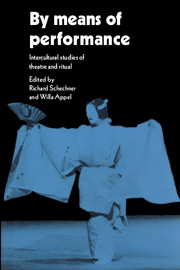Book contents
- Frontmatter
- Contents
- List of figures
- Notes on contributors
- Concerning Victor Turner
- Introduction
- 1 Are there universals of performance in myth, ritual, and drama?
- 2 Magnitudes of performance
- 3 Liminality: a synthesis of subjective and objective experience
- 4 The Yaqui deer dance at Pascua Pueblo, Arizona
- 5 A Yaqui point of view: on Yaqui ceremonies and anthropologists
- 6 Performance of precepts/precepts of performance: Hasidic celebrations of Purim in Brooklyn
- 7 The significance of performance for its audience: an analysis of three Sri Lankan rituals
- 8 What does it mean to “become the character”: power, presence, and transcendence in Asian in-body disciplines of practice
- 9 Korean shamans: role playing through trance possession
- 10 The practice of noh theatre
- 11 The profanation of the sacred in circus clown performances
- 12 Ethnographic notes on sacred and profane performance
- 13 The spatial sense of the sacred in Spanish America and the American South and its tie with performance
- 14 Space and context
- 15 The transformation of consciousness in ritual performances: some thoughts and questions
- 16 Universals of performance; or amortizing play
- Appendix
- Bibliography
- Index
9 - Korean shamans: role playing through trance possession
Published online by Cambridge University Press: 05 June 2012
- Frontmatter
- Contents
- List of figures
- Notes on contributors
- Concerning Victor Turner
- Introduction
- 1 Are there universals of performance in myth, ritual, and drama?
- 2 Magnitudes of performance
- 3 Liminality: a synthesis of subjective and objective experience
- 4 The Yaqui deer dance at Pascua Pueblo, Arizona
- 5 A Yaqui point of view: on Yaqui ceremonies and anthropologists
- 6 Performance of precepts/precepts of performance: Hasidic celebrations of Purim in Brooklyn
- 7 The significance of performance for its audience: an analysis of three Sri Lankan rituals
- 8 What does it mean to “become the character”: power, presence, and transcendence in Asian in-body disciplines of practice
- 9 Korean shamans: role playing through trance possession
- 10 The practice of noh theatre
- 11 The profanation of the sacred in circus clown performances
- 12 Ethnographic notes on sacred and profane performance
- 13 The spatial sense of the sacred in Spanish America and the American South and its tie with performance
- 14 Space and context
- 15 The transformation of consciousness in ritual performances: some thoughts and questions
- 16 Universals of performance; or amortizing play
- Appendix
- Bibliography
- Index
Summary
Korean shamans can be roughly divided into two types: possessed, or charismatic shamans and hereditary shamans. The former, most of whom are female, called naerim mudang, are typically found in the northern half of the Korean peninsula. After suffering from sinbyǒng, an illness which is generally interpreted as a sign of a shamanistic calling, a potential naerim mudang apprentices herself to an established shaman from whom she acquires the knowledge and skills appropriate to her new occupation. The two women establish a “spirit mother” – “spirit daughter” relationship, the spirit mother later conducting the initiation rite which transforms her apprentice into a full-fledged shaman. In the course of their rites, these shamans not only become possessed and experience ecstatic trance states themselves but may also induce their clients to do the same.
The hereditary shamans, both male and female, called tangol mudang, are found in the southern half of the Korean peninsula. They are recruited not through possession sickness but simply by being born into a shaman's family. This type of shaman does not personally undergo trance possession but may cause other persons to become possessed in the course of a rite.
Types of trance possession
There are at least three different types of trance possession in Korean shamanism, chinogwi-kut, sumangogu-kut, and mugam dancing. The first, performed by the naerim mudang, can be seen in the rite performed to guide the spirit of a deceased person to the other-world.
- Type
- Chapter
- Information
- By Means of PerformanceIntercultural Studies of Theatre and Ritual, pp. 149 - 166Publisher: Cambridge University PressPrint publication year: 1990
- 5
- Cited by



